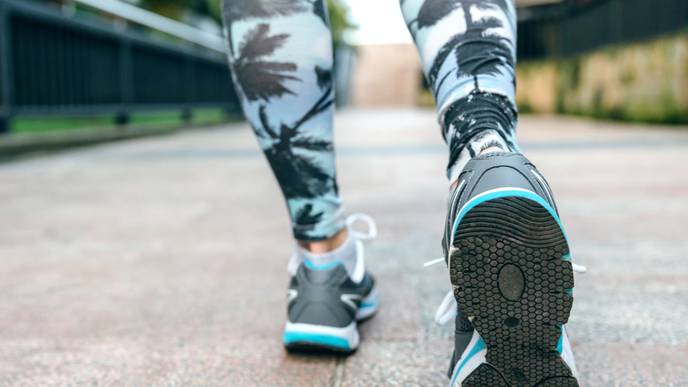ReachMD
Be part of the knowledge.™Increasing Walking Speed May Cut Diabetes Risk

Picking up your pace when you walk could offer extra protection against developing type 2 diabetes.
In a new study published in the British Journal of Sports Medicine, researchers in Iran determined that maintaining a habitual walking speed of 2.5 miles per hour (mph) or faster significantly lowered the chances of having type 2 diabetes in the future.
Every 0.6 mph increase was associated with a 9 percent risk reduction.
“Our results provide support for the incorporation of walking speed into physical activity guidelines,” says lead study author Ahmed Jayedi, PhD, a researcher in nutrition at Semnan University of Medical Sciences in Iran. “While current strategies to increase total walking time are beneficial, it may also be reasonable to encourage people to walk at faster speeds to further increase the health benefits of walking.”
When it comes to frequency, the Centers for Disease Control and Prevention (CDC) already recommends getting at least 150 minutes a week of moderate exercise to maintain overall health. This can be in the form of brisk walking, which is at a pace of 3 mph or faster, according to the CDC.
The health agency also estimates that the average walking pace for an adult is about 3 mph — so if you’re keeping up with the average, you could be on track for greater potential disease protection, according to this investigation.
Higher Walking Speed Equals More Benefit
To arrive at these results, Dr. Jayedi and his team analyzed data from 10 studies that explored the association between walking speed and the risk of type 2 diabetes in adults. The prior studies, which were published between 1999 and 2022, monitored just over half a million adults from the United States, Japan, and the United Kingdom, for periods ranging from 3 to 11 years.
Pooled data analysis revealed that compared with strolling at under 2 mph, an average or normal walking speed of 2 to 3 mph was associated with a 15 percent lower risk of type 2 diabetes, regardless of the time spent walking.
Fairly brisk walking at a speed of 3 to 4 mph was associated with a higher disease-risk reduction of 24 percent compared with strolling. That risk reduction jumped to 39 percent if habitual walking pace was greater than 4 mph.
Study authors estimated that this highest level of risk reduction was the equivalent of 2.24 fewer cases of type 2 diabetes per every 100 people.
The analysis emphasized that the key to getting the benefit was reaching the threshold of a habitual walking speed of 2.5 mph — or 87 steps per minute for men and 100 steps per minute for women.
A fitness tracking device like a pedometer may help keep accurate track of speed. Without such a device, the CDC says you can tell if you’re doing moderate-intensity physical activity if “you can talk, but not sing during the activity.” At a higher “vigorous” level, you won’t be able to say more than a few words without pausing for a breath, according to the health agency.
How Increasing Walking Intensity May Help
The results are in line with what experts already know about exercise and diabetes risk. The American Diabetes Association stresses that regular physical activity is an important part of managing diabetes or dealing with prediabetes. When you’re active, your cells become more sensitive to insulin, so it works more effectively to lower your blood sugar.
“The faster someone walks, the more effort they exert — which in turn may improve fitness, reduce and manage weight, and reduce insulin resistance,” says Michael Fang, PhD, an assistant professor in the department of epidemiology at the Johns Hopkins Bloomberg School of Public Health in Baltimore, whose research interests include diabetes and wearable technology.
While higher walking speeds may provide greater risk reduction, Robert Gabbay, MD, the chief scientific and medical officer with American Diabetes Association, suggests that any level of regular walking will provide benefits.
“Overall, I think the message is that walking is an important way to improve your health,” says Dr. Gabbay, who was not involved in the study. “It may be true that walking faster is even better, but given the fact that most Americans do not get sufficient walking in the first place, it is most important to encourage people to walk more as they’re able to.”
Dr. Fang cautioned that results were limited because the research was based on summarized observational studies rather than clinical trials. “This is important because it means people may have had preexisting differences in their health [that were not captured in this type of study],” says Fang, who was not involved in the latest study.
“People who are able to walk faster are likely healthier to begin with. That means we’re not sure if the relationship between walking speed and reduced diabetes risk is actually caused by the walking, or by baseline differences in health.”
Pushing the intensity of habitual walking is a practice that people can easily incorporate into their everyday lives, according to study author Jayedi.
“We can increase our walking time and speed when going to work, to school or university, and walking with friends,” he says. Tracking walking speeds and setting goals related to speed may also help. “While any time spent walking per day is better than no walking at all, walking at faster speeds may increase health benefits of walking, independent of the total volume of physical activity or time spent walking per day.”
Facebook Comments